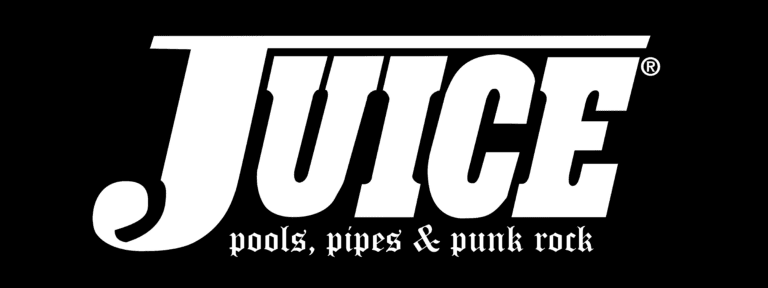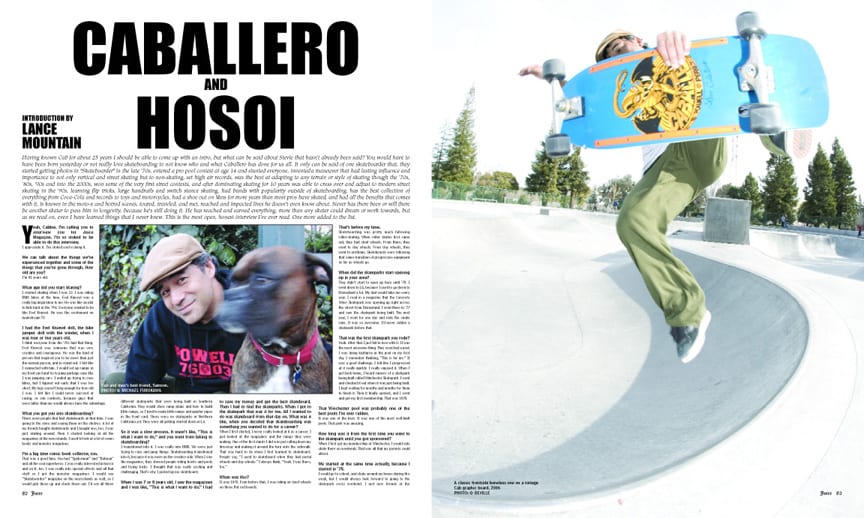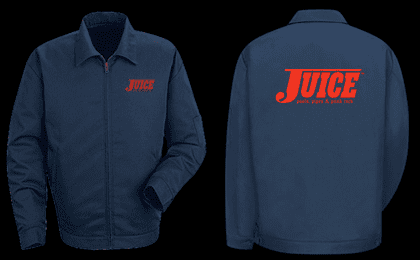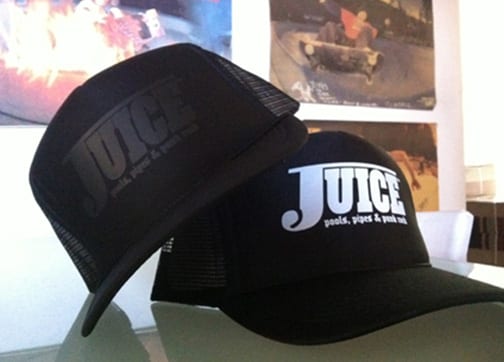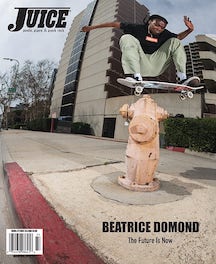INTERVIEW BY CHRISTIAN HOSOI
INTRODUCTION BY LANCE MOUNTAIN
PHOTOS BY MICHAEL FURUKAWA, DEVILLE, GLEN E. FRIEDMAN AND TED TERREBONNE
Having known Cab for about 25 years I should be able to come up with an intro, but what can be said about Stevie that hasn’t already been said? You would have to have been born yesterday or not really love skateboarding to not know who and what Caballero has done for us all. It only can be said of one skateboarder that, they started getting photos in ‘Skateboarder’ in the late ’70s, entered a pro pool contest at age 14 and stunted everyone, invented a maneuver that had lasting influence and importance to not only vertical and street skating but to non-skating, set high air records, was the best at adapting to any terrain or style of skating though the ’70s, ’80s, ’90s and into the 2000s, won some of the very first street contests, and after dominating skating for 10 years was able to cross over and adjust to modern street skating in the ’90s, learning flip tricks, large handrails and switch stance skating, had bands with popularity outside of skateboarding, has the best collection of everything from Coca-Cola and records to toys and motorcycles, had a shoe out on Vans for more years than most pros have skated, and had all the benefits that comes with it, is known in the moto-x and hotrod scenes, toured, traveled, and met, reached and impacted lives he doesn’t even know about. Never has there been or will there be another skater to pass him in longevity, because he’s still doing it. He has reached and earned everything, more than any skater could dream or work towards, but as we read on, even I have learned things that I never knew. This is the most open, honest interview I’ve ever read. One more added to the list.
“EVEL KNIEVEL WAS A REALLY BIG INSPIRATION TO ME. HE WAS LIKE AN IDOL TO KIDS BACK IN THE ’70S. EVERYONE WANTED TO BE LIKE EVEL KNIEVEL.”
Yeah, Cabbie. I’m calling you to interview you for Juice Magazine. I’m so stoked to be able to do this interview.
I appreciate it. I’m stoked you’re doing it.
We can talk about the things we’ve experienced together and some of the things that you’ve gone through. How old are you?
I’m 41 years old.
What age did you start skating?
I started skating when I was 12. I was riding BMX bikes at the time. Evel Knievel was a really big inspiration to me. He was like an idol to kids back in the ’70s. Everyone wanted to be like Evel Knievel. He was the excitement on mainstream TV.
I had the Evel Knievel doll, the bike jumper doll with the winder, when I was four or five years old.
I think everyone from the ’70s had that thing. Evel Knievel was someone that was very creative and courageous. He was the kind of person that inspired you to be more than just the normal person, and to stand out. I felt like I connected with him. I would set up ramps in my front yard and try to jump garbage cans like I was jumping cars. I ended up trying to race bikes, but I figured out early that I was too short. My legs weren’t long enough for how old I was. I felt like I could never succeed at racing, or win contests, because guys that were taller than me would always have the advantage.
What you got you into skateboarding?
There were people that had skateboards at that time. I was going to the store and seeing them on the shelves. A lot of my friends bought skateboards and I bought one, too. I was just skating around. Then I started looking at all the magazines at the newsstands. I used to look at a lot of comic books and monster magazines.
I’m a big time comic book collector, too.
That was a good time. You had ‘Spiderman’ and ‘Batman’ and all the cool superheros. I was really interested in horror and sci-fi, too. I was really into special effects and all that stuff so I got the monster magazines. I would see ‘Skateboarder’ magazine on the newsstands as well, so I would pick those up and check those out. I’d see all these different skateparks that were being built in Southern California. They would show ramp plans and how to build little ramps, so I tried to make little ramps and quarter pipes in the front yard. There were no skateparks in Northern California yet. They were all getting started down in LA.
So it was a slow process. It wasn’t like, ‘This is what I want to do,’ and you went from biking to skateboarding?
I transitioned into it. I was really into BMX. We were just trying to race and jump things. Skateboarding transitioned into it, because it was more on the creative side. When I saw the magazines, they showed people riding bowls and pools and trying tricks. I thought that was really exciting and challenging. That’s why I picked up my skateboard.
When I was 7 or 8 years old, I saw the magazines and I was like, ‘This is what I want to do.’ I had to save my money and get the best skateboard. Then I had to find the skateparks. When I got to the skatepark that was it for me. All I wanted to do was skateboard from that day on. What was it like, when you decided that skateboarding was something you wanted to do for a career?
When I first started, I never really looked at it as a career. I just looked at the magazines and the ramps they were making. One of the first stunts I did was just rolling down my driveway and making it around the turn onto the sidewalk. That was hard to do when I first learned to skateboard. People say, ‘I used to skateboard when they had metal wheels and clay wheels.’ I always think, ‘Yeah. I was there, too.’
When was this?
It was 1976. Even before that, I was riding on steel wheels on those flat red boards.
That’s before my time.
Skateboarding was pretty much following roller-skating. When roller skates first came out, they had steel wheels. From there, they went to clay wheels. From clay wheels, they went to urethane. Skateboards were following that same transition of progressive equipment as far as wheels go.
When did the skateparks start opening up in your area?
They didn’t start to open up here until ’78. I went down to LA, because I used to go down to Disneyland a lot. My dad would take me every year. I read in a magazine that the Concrete Wave Skatepark was opening up right across the street from Disneyland. I went there in ’77 and saw the skatepark being built. The next year, I went for one day and rode the snake runs. It was so awesome. I’d never ridden a skatepark before that.
That was the first skatepark you rode?
Yeah. After that I just fell in love with it. It was the most awesome thing. They even had a pool. I was doing kickturns in the pool on my first day. I remember thinking, ‘This is for me.’ It was a good challenge. I felt like I progressed at it really quickly. I really enjoyed it. When I got back home, I heard rumors of a skatepark being built called Winchester Skatepark. I went and checked it out when it was just being built. I kept waiting for months and months for them to finish it. Then it finally opened, and I went and got my first membership. That was 1978.
That Winchester pool was probably one of the best pools I’ve ever ridden.
It was one of the best. It was one of the most well-built pools. That park was amazing.
How long was it from the first time you went to the skatepark until you got sponsored?
When I first got my membership at Winchester, I would only skate there on weekends. That was all that my parents could afford.
We started at the same time actually, because I started in ’78.
I would go to school, and skate around my house during the week, but I would always look forward to going to the skatepark every weekend. I met new friends at the skatepark, and I was just so hyped. Then all of a sudden, another park popped up a mile away. It was called Campbell Skatepark. They were always competing against Winchester, so they had this deal that if you bought a month pass, it only cost $1 a day to skate. You could skate all day at the skatepark and it would only cost $30 a month. I was like, ‘Man, I’m on that.’ The sessions at Winchester were like $3.75 for two hours, so I stopped going to Winchester and started going to Campbell every day. I would take the bus after school and go there.
Campbell became your local park.
Yeah. I was really excited to skate there. Then they put together a skatepark team. They would have local contests at the park so you could get on the team. They had an A team, a B team and a C team. If you made it to the A team, you were able to travel around the whole Bay area. Other parks had started to pop up at that time, so we started entering competitions all around the Bay area. Each park had a team. The ironic thing was that Winchester never had a team. They never competed with the other parks. There were parks in Sacramento, Modesto and Cupertino. All the cities had their own skateparks and park teams. Then it became a big series. I ended up getting on the Campbell Skatepark team. That was my first real sponsorship. Campbell Skatepark was getting flowed by Santa Cruz Skateboards, so we were getting product from Santa Cruz.
Who was your first big sponsor?
After we had entered all the contests around the Bay area, we had become the best team. Then we got invited to San Diego to the USASA Nationals at Escondido Skatepark. That’s the first time I ever met Eddie Elguera. I’d heard a lot about him. I knew he was the top amateur. Then I saw him skate. It was amazing. I was trying to learn all these tricks, and Eddie was inventing all these new tricks. He was the guy. That’s how I ended up meeting Stacy Peralta. Stacy Peralta and Steve Cathey from G AND S were the judges at the contest. I’d heard of Stacy from the magazines and him being a Z-Boy. I knew of him from Dogtown and being sponsored by G AND S. I knew who Steve Cathey was, too. It was pretty exciting to finally see some professionals in person.
The guys that were in the magazines, all of a sudden, were standing in front of you.
Yeah. They were judging me in a contest. One of the guys on our team, Clay Townsend, ended up taking first place and I got fifth place. After the competition, Stacy approached Clay and me, and asked if we wanted to ride for his new company. He said, ‘I’m starting a new company with this gentleman George Powell. We’re going to call it Powell/Peralta. We want you to be part of it.’ I was like, ‘Wow. That’s kind of cool.’ But I didn’t know what it entailed, so I told Stacy I had to ask my parents if I could be a part of the team and leave the Campbell Skatepark team.
[Laughs.]
It was funny. I had no idea what it meant to be sponsored by a skate company. For one, it wasn’t even a company. I didn’t know what it was. I had a month to think about it, because the next month Stacy was coming up to Winchester to enter a Hester Series contest. He said, ‘Think about it for a month and then when I come up there to skate, you can let me know.’ I said, ‘Okay.’ I talked to my parents about it, and they said, ‘Yeah. That would be kind of a cool thing.’ What’s funny is that the skatepark owner was trying to get the whole team sponsored by Powell. We had to explain to him that they only wanted Clay and me. After Stacy came up, we had decided that we wanted to ride for his company. So we said, ‘Yeah.’ So Powell was my first sponsor.
Did you enter that Hester Contest?
No. It was a pro contest. That was in 1979. That was the beginning.
That was the beginning of your 25-year career.
[Laughs.] Yeah.
You just got an achievement award at the tradeshow last year, right?
Yeah. It was a 25th anniversary limited edition commemorative skateboard from Powell with one of my first graphics on it. They made a limited edition run. It was 1-500 with the graphic that was created in 1980.
What an achievement that is. Who would ever think that your career would last this long? And it’s still going. That’s what so awesome about it. You had this big impact on so many people’s lives. You were the phenomenal skater. You were beyond good. You were going up against Duane Peters and Eddie Elguera. Who else was your competition in the Gold Cup Series?
I was going against the top dogs who were Eddie Elguera, Duane Peters, Dave Andrecht, Eric Grisham, Steve Hirsch, Steve Alba and Micke Alba. The Gold Cup Series started in 1980 and ended in 1981.
I remember being 11 years old and an amateur at Big O. I took 9th place. At Oasis, I got like 20th place, because I locked up on a backside air.
I did pretty crappy at that one, too. Oasis was my first pro contest. I was really nervous. I ended up getting 11th place.
Wow. [Laughs.] You bottomed out at 11th?
[Laughs.] I was scared. I’ve always been very competitive.
When the Gold Cup went to Marina, which was my home park, I ended up getting first place. I was riding for Powell/Peralta and you were riding for the Bones Brigade. It was insane for me, at the time, looking up to you. I remember Lance Mountain and the top dogs like Gator, Lester and Neil Blender. Those were the heavy-duty ams that went pro after the Gold Cup. Ray Bones was another one of those guys and so were Mike McGill and Alan Gelfand.
I remember when I first met you. I was at the Marina Skatepark in 1979 or 1980. I remember first seeing you skate in the little brown bowl. You were this short little dude, who I thought was a girl.
[Laughs.]
You hair was down to your butt. I’d never seen hair that long. You were ripping the brown bowl. I remember going to the upper keyhole with you. I was watching you trying to tail drop in. You were scared to tail drop.
That’s awesome.
Yeah. That’s when I first saw you skating. You went from being scared to drop in the keyhole to blasting 10-11 foot airs. It was pretty amazing.
It feels like yesterday that I was sitting there on a tail drop, trying to drop in and looking down at that tile. There wasn’t much vert in that back keyhole, but to do those first tail drops, I tell you, I can feel it right now in my gut.
You started out scared to drop into the bowl and went to flying that same height out of the bowl. It’s pretty awesome to see where you’ve come from and to see the impact that you made on this sport, too.
You are one of the people that really pushed me to ride better, to ride smoother. I took a lot from you that I didn’t take from a lot of people, because there wasn’t much to take from. That’s why we clicked. That’s why we hung out.
Vice versa. You really pushed me. I admired how confident you were, how you spoke, how you pushed yourself on a skateboard, how you made tricks look, how fluid you made them and how high you went. I wanted to go higher.
Remember the competition and the energy back then? What about the sponsorships and the way the industry was?
Well, back then, being sponsored reflected your ability to skate pools and half pipes. It was based on your contest record. It was about how well you did in contests. There was no such thing as videos or video parts. Back then, signature decks weren’t popular. There were no signature shoes. There weren’t that many companies. The main companies were Santa Cruz, Vision, Powell, Variflex and G AND S. The scene was a little bit smaller. It wasn’t so global. It was pretty much Nor Cal and So Cal based as far as competition. The magazines were covering a lot of stuff that was happening on the West Coast, even though there were things happening on the East Coast and in Europe.
After the skateparks closed, we did the backyard ramps. It was a small industry. I remember it being so tight. Skaters were just into having fun. Today, it seems so mixed. Some people are having fun. Some people are all business. Some people are picking street or vert or pools. Now you have these skateparks that are mixing all three elements. They have the pools, the bowls, and the street course.
Back then, your choices were that you could be a freestyler, a downhill slalom racer or a bowl rider. I chose bowl riding because I thought it was a lot gnarlier and more fun.
There seems to be more pressure on skaters now, because there’s a lot more money involved now. Back then, we were skating for fun. We were very young. Skateboarding was young. There really wasn’t a history to the sport yet. We were writing history as we were doing it. It was a special time. I just remember being so hungry to skate and not worried about the sponsorship. Whereas today, everyone is so worried about sponsorship. Sponsorship is important, but kids have such pressure on them about whom they’re identified with, and whether they are a street skater or a vert skater. Back then, we were just skaters.
I know what you’re trying to say. There are a lot of kids that get into skateboarding for the wrong reasons. They see the money and the fame that comes with the sport today, because of how accepted it is now. Back in the day, it wasn’t accepted, so it wasn’t like you could come into skateboarding and go, ‘Yeah. I’m going to make a career out of this.’ That wasn’t even a possibility. We just did it because it was fun. It was challenging. That’s the difference. It wasn’t as glamorized as it is today. Back then it wasn’t cool to be a skateboarder. It was an outlaw thing. It wasn’t as respected as it is now. I’m glad I was part of that time, but I’m glad that I’m part of this time, too, because the opportunities that skaters have today are awesome. I’m enjoying those same opportunities.
There area so many skateparks now.
Public skateparks are popping up all over the world. That was unheard of back in the day. If you wanted to skate a cement skatepark, you had to pay to skate. Now you can skate all these parks for free. That’s one of the benefits of today’s skateboarding. The fact that we laid the foundation for what’s going on today is pretty cool. I’m glad that I’m still part of it and I got to see that change and transition. I still have the same love for skateboarding that I did in the beginning. I finally made the choice that this is what I wanted to do for a living. When I started skateboarding, that wasn’t even an option. When I was leaving high school, there was no way I would tell my teachers, ‘After high school I’m going to be a professional skateboarder and make a living at it for the next 25 years.’ That would have been ridiculous.
In the mid ’80s, skateboarding became huge. I remember when I had to decide if I was going to finish high school or continue my skating career. I was making thousands of dollars a month. I know you were probably making pretty good money, too. I remember us having huge sponsors, and traveling around the world.
I’d just gotten my board in 1980. In ’82, I graduated high school and my checks were $500 a month. At age 17, making $500 a month was pretty good. Then a month later, I was making $1,000 a month. Five years later, I was making $18,000 a month. In 1987, I made over $250,000 in just board sales. That was just getting $1 a deck royalty. Can you imagine getting $2 a deck?
Yeah. Now it’s $2 or $3 dollars a deck.
Yeah. Powell/Peralta was raking in good money back then.
Some of my favorite times of skateboarding were some of the times we were doing demos together and we’d do doubles. I remember some of the huge World Expo contests we entered up in Vancouver, Canada. We were always hanging out together behind the scenes, when we weren’t skating. Those were some precious times for me.
Back then, the industry was so small. Every time we’d go to a ramp contest or a pool contest, we’d always hang out. We’d stay at the same hotel and go to the same parties and we’d go see punk shows. Our scene was pretty tight.
Some of those times were epic, like at Raging Waters. That was insane, just hanging out in San Jose.
Yeah. You guys were always coming over to my house to skate my ramp. Then you got that picture in ‘Thrasher’ of you bomb dropping off my roof. Those were classic times.
Your ramp was sick. What was the size of that ramp?
I tried to copy the Winchester pool, and the Winchester pool had 8-foot trannys. When I first built the ramp, it was 9-feet high. It had a foot of vert and 8-foot trannys. It was 12 feet wide. Then the ramp started getting bigger and bigger. Lance helped me add some more vert to it. We ended up putting two more feet of vert. When I kept re-plying it, the vert would drop off. It ended up being 9-foot transitions with 2 feet of vert. It was 11 feet high and 12 feet wide.
Wow.
It took up the whole backyard. I’ve been very fortunate that my mom let me build that ramp in the backyard, because after Winchester closed, there was no vert anywhere. In order for me to continue skating vert and progressing, I had to do something, so I built that ramp in my backyard.
It had skateable flat bottoms. When did you start building that ramp?
It was ’81. Winchester closed in ’81. It had 12 feet of flat bottom and PVC coping on it. One side had a 4-foot deck and the other side had a 2-foot deck. It was really close to the house. The whole backyard was pretty much my ramp.
I was so stoked on it.
It was so cool, because at the same time, we were going to a lot of punk rock shows. Corey and Gavin O’Brien and I decided to start a band. Then we started having band practice in one of the back rooms. I’d have people over ever day skating. We’d go do band practice and then come back and skate. We did that every day.
FOR THE REST OF THE STORY, ORDER ISSUE #60 BY CLICKING HERE…
SHARE THIS POST:
- Click to email a link to a friend (Opens in new window)
- Click to share on Tumblr (Opens in new window)
- Click to share on LinkedIn (Opens in new window)
- Click to share on Pinterest (Opens in new window)
- Click to share on Twitter (Opens in new window)
- Click to share on Facebook (Opens in new window)
- Click to share on Reddit (Opens in new window)
- Click to print (Opens in new window)
